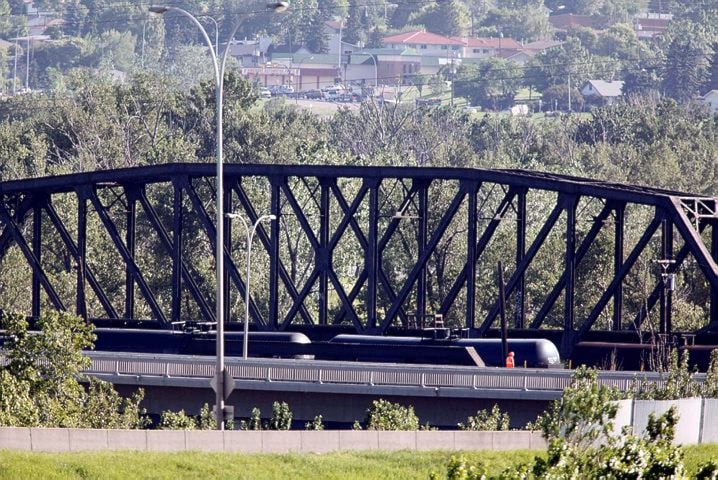CALGARY — An emergency official says a train going over a bridge spanning the swollen Bow River in Calgary derailed when the structure collapsed and as many as five tanker cars carrying fuel are slowly sinking into the water.
Emergency management director Bruce Burrell says the cars are not leaking, but the bridge is failing and slowly sagging into the river.
“The bridge is continuing to drop as we speak, so that distance between the failure point and where the bridge decking is, is starting to open up more,” he said.
“It appears that the bridge is failing.”
Ed Greenberg, a spokesman for Canadian Pacific Railway (TSX:CP), said the freight train was eastbound when it left the tracks.
“They are all upright,” he said of the derailed cars. “There are no leaks reported and no injuries reported as a result of the incident.”
Acting fire chief Ken Uzeloc said there are a total of six cars remaining on the bridge. One is an empty oil tanker and five are carrying a type of diesel fuel or possibly kerosene.
The Transportation Safety Board says only five cars are involved — four full and one empty.
The bridge gave way after most of the train had crossed. Cars that were still on the tracks were pulled away from either end.
The immediate area around the derailment has been evacuated. It’s primarily an industrial part of the city and there is a large railyard nearby.
Uzeloc said crews are planning to string a cable through the railcars and secure it to bulldozers on land so that, if the bridge gives way, the cars won’t be carried down the river. He said workers are hoping to use a bucket truck for that operation so no one has to go on the bridge.
Crews then hope to pull another train along a parallel bridge so the cargo can be pumped off and the empty cars can be removed with a crane.
“The thing we want to do is secure the cars. The last thing we want is these cars floating down the river and causing problems downstream,” Uzeloc said.
Both the Bow and Elbow rivers that run through Calgary burst their banks when heavy rain pounded southern regions of Alberta last week. Authorities have not said if flooding was responsible for the structural failure.
Canadian Pacific said the bridge was inspected by a qualified inspector on Saturday and the track was inspected on Monday. Additional inspections were scheduled.
Uzeloc said the city doesn’t inspect rail bridges because they fall under federal jurisdiction.
Dozens of police vehicles and fire trucks were on the scene. Major roads in the area, including the Deerfoot Trail expressway, were closed. Uzeloc said the reason for that was obvious.
“Each car could have about 80,000 pounds of product in that car and they’re all flammable liquids, so if something does go wrong, we could have a very big pile of burning material. And also then you have the smoke and the combustibles in the air that come off that,” he said.
“I don’t want people driving through thick black smoke clouds on Deerfoot Trail that could have the potential of causing other accidents.”
The derailment is further stretching emergency crews who have been working flat out for a week dealing with flooding, Uzeloc said.
“If I was at the emergency management college taking the training ... I would expect this because this is what usually happens ... one on top of another,” he said. “Not really expecting it in real life, so it’s going to be adding on to a lot of responders who have already been working long hours.”
